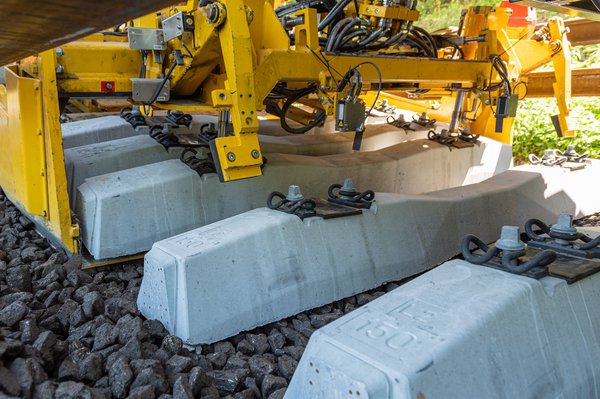The concept behind the RUS 1000 S is based on the RU 800 S, a machine that combines track renewal and ballast bed cleaning. The knowledge and experience gained from daily operation shaped the new machine’s work technology. Plasser & Theurer, Swietelsky, and Austrian Federal Railways (ÖBB) successfully developed the machine together. After some final adjustments, this partnership has now put the RUS 1000 S into regular operation.
Wider range of use
In summary, these adjustments optimised the work units and increased overall output. Like its predecessor, the new machine follows a logical and technologically correct operation sequence: it cleans the ballast before laying the new sleepers. Plus, the RUS 1000 S can handle minimum working radii of 250 m, which it did during a job in the Arlberg mountain range in Austria. Its drive power is higher: the RUS 1000 S can effortlessly travel along tracks with a 30 ‰ gradient. Its structure gauge was designed in accordance with the UIC 505-G1 clearance gauge to make it ideal for use throughout Europe. The machine is also greener, with CO2 emissions reduced by up to 30 % as well as noise reduction.
Increased quality and performance
A new screening unit achieves a greater output per metre while retaining an optimal granulation size. The machine is also able to lay more sleepers. The laying unit now has a laying cycle of 10 sleepers per minute. Itcan also process various types of sleepers (mono-block concrete, bi-blockconcrete, wooden sleepers).
The RUS 1000 S strengthens the ballast bed’s layered structure. Some of the cleaned ballast is immediately sent to the area behind the excavating chain and pre-consolidated. This provides a stable ballast formation for laying new sleepers. Once the new sleepers and new rails have been laid and connected, another load of cleaned ballast is transported to the shoulder excavating and tamping module to lay a new layer.
Travel on the track immediately
The next step is to lift, line, and tamp the track. The tamping system consists of a lifting and lining unit as well as a tamping unit. This is completely new for this machine model. The first tamping cycle (normally there are three) is integrated into the track renewal machine. This means that already after this one pass, the RUS 1000 S provides high-quality track geometry for when rail traffic resumes. Additionally, it is possible to settle the newly laid track into a lowered, corrected position.




